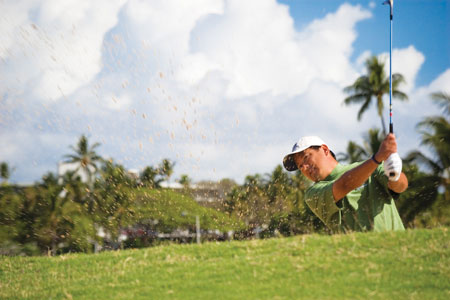 Be Confident
Be Confident
Aaah . . . the dreaded bunker shot!
Many amateur golfers fear it, and for good reason. Bunkers are a reminder of a bad shot you just made (how you ended up in the bunker in the first place) or bad past experiences. Either way, the result is a lack of confidence, which can detract from your game.
My advice for your bunker shot: Maintain stable wrists. Many amateurs will try to “help” the ball out of the bunker, which weakens the wrists. When the club enters the sand, the club head won’t go through the sand, leaving the ball in the bunker.
Try this technique instead:
• Open your stance a bit.
• Open the clubface.
• Have the club head enter the sand about two inches behind the ball.
• Follow through with strong wrists.
• Be confident!
Confidence—the most important swing fundamental—develops through the repetition of success. Executing a bunker shot requires a positive frame of mind and positive visualization of the shot. Keeping strong wrists helps you swing confidently. Regardless of the mechanics used, confidence is the key to good golf.
Ed Kageyama, PGA
General Manager
Ka‘anapali Golf Resort
Line it Up
To simplify putting, always mark your golf ball with a line. It will help you match your ball with your intended putting line to the hole. This will give you more confidence and help you make more putts inside of ten feet. Not convinced? The #1 player in the world does it!
Eric Johnson
Golf Operations Manager
Makena Resort and Golf Course
Know Your Greens
Before you play, know what kind of grass you’ll be putting on. Many courses use Bermuda grasses, which are known for their grain, but not all Bermuda grasses are identical. For example, the Wailea Blue Course uses a type of Bermuda grass called Tifton 328, which has less grain than the Tifdwarf used on the Wailea Gold and Wailea Emerald greens.
In Hawai‘i, everything breaks toward the ocean, even if it doesn’t look like it will. Golf pros recommend you play more break than you think.
If you’re putting uphill into the grain, you’ll need to use a little more force. Putting downhill and down-grain requires less force.
Be firm on the three- to five-foot putts to compensate for the break, or give it more break if you try to die the putt in the hole.
How to tell which way the grain is going? Look at the cup, especially in the afternoon. Half of the cup is likely to look ragged, while the other side is smoother or sharper. The smoother side is the direction the grass is growing. The ragged look is caused by the grass’s tendency to fray as it grows.
Rusty Hathaway
Head Golf Professional
Wailea Golf Club






